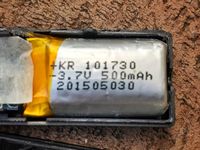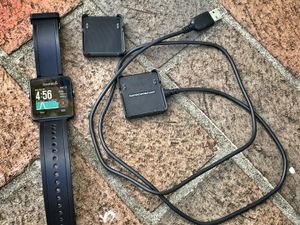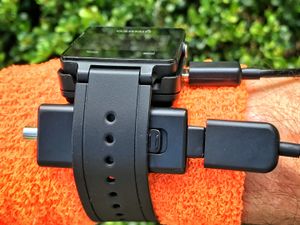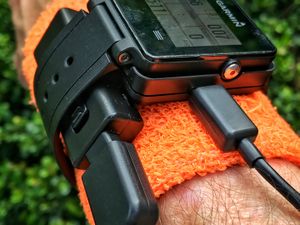Charging a watch while running
Even the Best Running Watch doesn't have the battery life for longer ultramarathons. Even those with the longer battery lives ten to run out around 20-24 hours, and that's under optimal conditions. Most runners in a 100-mile race will need a little longer at least. One option is to reduce the GPS polling interval, which bumps the battery life up to 30-200-hours depending on the watch, but this can also cripple GPS Accuracy. Another option to consider is to charge the battery while running, something that can work quite well.
Most watches have fairly low capacity batteries, far smaller than a smartphone, so it doesn't take much to top them up. For instance, the Garmin Fenix 3 has about a 350 mAh (milliamp-hour) battery, so the problem is generally finding a battery pack that's small enough, as batteries tend to be heavy. My two preferred options are below, the Anker and the PulsePak.
The Anker is much bigger (3.75"/9.5cm) and heavier (2.9oz/82g), though it's shape makes it easy to carry in your hand and it will slip into the pockets of Race Ready shorts. It holds 3,350 mAh, which is way more than you need, recharging the Fenix 3 over ten times. It's reasonably priced at Error: Could not parse data from Amazon!. The PulsePak is far smaller (2"/5cm), lighter (0.5oz/15g), and cheaper at Error: Could not parse data from Amazon!. It only holds 500 mAh, but that's enough for a full charge, and it's small enough to carry a couple.
Contents
1 Charging in the Rain
One concern I have with this approach is the issue of charging the watch in the rain. I've never tried this, and I'm a little concerned that something might short-circuit and damage the watch. If anyone has any experience with this, please let me know.
2 Which Watch?
Obviously, you'll need a watch that supports charging while recording an activity. This means that some otherwise likely candidates such as the Garmin 920XT are out of the question, as they terminate the recording soon as they connected to power. Other watches, such as the Garmin Fenix 5X are poor choices because the location of the charging port means you can't wear the watch while it's charging. You could put these watches in a pocket or backpack, but that rather defeats the object of having a running watch when you can't see the display. This leaves us with a number of choices, and I've described the ones I feel a best below.
3 Garmin USB Mode
It's important to note that many Garmin watches have to have the USB mode set to "Garmin" to get the them to charge on the run and still display your data.
4 Garmin Fenix 3
The Fenix 3 is a great choice, as it has a good battery life, and the charging dock fits under the watch quite comfortably while you're wearing it. You can use the standard charging dock and cable that came with the Fenix 3, holding a battery in your hand, which is shown below. I'm not a fan of this approach as the battery occupies your hand and the cable is rather long. You can tuck the battery in a pocket, but then the cable really annoys me. (Putting the watch and battery in a pack or pocket seems to defeat the object of having a watch if you can't see it.)
You can use an adapter to use the PulsePak with the Garmin charger which requires a full-size USB plug, which makes the batter lighter, but still isn't ideal.
Inspired by David Jackson's blog], I decided a better approach is to use an aftermarket dock. The advantage of the aftermarket dock is that it has a microUSB socket rather than a cable, which is Error: Could not parse data from Amazon!. While the quality of the aftermarket dock is not quite as good as the Garmin original, it's surprisingly close. Because the dock sits under the watch, it naturally stays in place.
Here you can see the microUSB socket with the dock worn under the watch. The underside of the dock does not cause me any problems, such as skin irritation or pressure points.
Here's the PulsePak plugged into the dock while being worn. I've not had a problem with the battery sticking out. You could use a micro-USB extension cable and tuck the battery into the wristband of the watch, but I preferred this simpler approach.
I find it's a little more comfortable worn over a wrist band. The thickness of the wristband combined with the thickness of the dock does make the watch feel a little more cumbersome.
4.1 Recharge Time
I did some analysis to see how long it takes to charge the Fenix 3 when it's recording. The figures below are the time from completely depleted.
| Time (minutes) | Percent Charged |
|---|---|
| 15 | 10% |
| 26 | 20% |
| 39 | 30% |
| 53 | 40% |
| 55 | 50% |
| 77 | 60% |
| 90 | 70% |
| 103 | 80% |
| 115 | 90% |
| 138 | 100% |
5 Garmin Epix
While the Garmin Epix has been rather abandoned by my Garmin, with no firmware updates to fix bugs, it remains a high functioning watch at a price that starting to decline. The Garmin Epix has its charging port on the side, and the cable just clips in. You can see the standard cable below, along with an aftermarket adapter. (The yellow cable tie is just a marker so that I can find where the watch is plugged in when I've got lots of them on charge at the same time.)
As with most other watches, you can wrap the long cable around your arm and hold the battery in your hand, though this is a little cumbersome.
Here is a side view showing how standard connector clips on.
You can buy a cheap aftermarket charging adapter that has a micro-USB port Error: Could not parse data from Amazon!.
Rather annoyingly, the micro-USB port is on the underside of the adapter; life would've been a lot easier had it been on the top.
I found the best option was a short (1'/30cm) right angle micro-USB cable that allowed me to tuck the smaller battery pack into the wrist strap (Error: Could not parse data from Amazon!). This is a less-than-perfect, but it works.
As you can see from this side view, even with the right-angle USB cable the plug tends to press on my wrist. The sweat band is needed to create enough of a gap for the plug.
6 Suunto Ambit2 and Ambit3
Both the Suunto Ambit2 and the Suunto Ambit3 support charging on the run. I couldn't find an aftermarket charging adapter, so you end up with a lot of excess cable to wrap around your wrist. You need to wear the watch on your left wrist, so the charging clip goes up your arm and doesn't get hit when you bend your wrist.
The charging clip is not too intrusive, and seems to stay in place reasonably well. Wearing a sweatband might make things a little more comfortable, but I didn't have an issue with it next to my skin. You can see from the photo that the clip is angled slightly upwards, which makes things easier.
7 Garmin Vivoactive
The Garmin Vivoactive is not an obvious choice for ultrarunning has its battery life is only 10 hours. I've included it here because it's a very small watch with a lot of functionality for a very low price, and it charges on the run fairly well. It only holds about 200 mAh, so it doesn't take much to fully charge it, though it seems to charge rather slowly. The charging cradle sits nicely under the watch body, and is attached magnetically, though this is immaterial as it's held in place when you're wearing it.
If you use the factory cable that comes with the watch you'll have to wrap the cable around your arm a little, but this works reasonably well. You should wear the watch on your right wrist, so the cable goes up your arm rather than against your hand, though the cable is flexible enough that wearing it on the left is not much of a problem.
You can get a fairly cheap aftermarket charging adapter, that provides some rather more convenient options Error: Could not parse data from Amazon!. As you can see from the close-up below, it has a micro-USB port on the right side of the charging plate.
The aftermarket charging plate allows you to plug the small USB battery directly into it, which makes for a nice, compact solution. You have to wear the watch on your right risked so the battery pack goes up your arm, but that shouldn't be too much of an issue. The biggest problem is that the alignment of the charging port and the micro-USB plug on the battery means that the battery sits a little too low. Wearing a sweatband creates a little extra room, but it's not perfect.
Another approach is to use the aftermarket charging adapter with a short USB extension cable and hold the small battery pack in your hand. This works okay, but I'm not a fan of holding anything if I can avoid it. (Note that you have to have a micro-USB extension cable, not a standard male to male cable. I got this three pack of extension cables and used the shortest Error: Could not parse data from Amazon!.)
The small USB battery pack will actually talk under the wristband reasonably well, and this became my preferred option. If you have larger wrists, you may have an issue with the watch strap reaching around. What I've done with other watches is to get a spare watch strap and turn it into an extension piece, and there are a vast array of aftermarket watch straps Vivoactive.
7.1 Recharge Time
Charging the Vivoactive while recording, it takes about two hours to go from empty to fully recharged. The recharge rate is fairly even, with each 25% taking about 30 minutes.






























